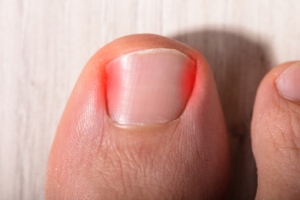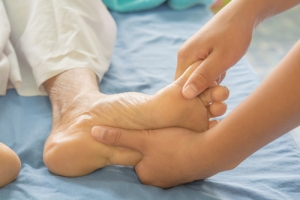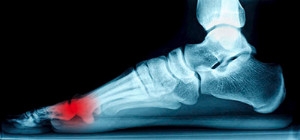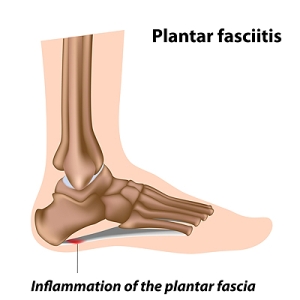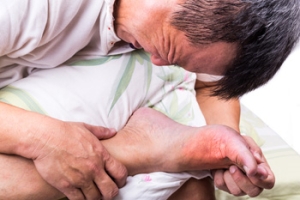
Possible Causes of Ingrown Toenails
 People who develop ingrown toenails are often aware of the pain and discomfort they can cause. Wearing shoes that do not fit correctly may cause the corner of the toenail to grow into the skin, and the affected area typically appears to be red and swollen. Additionally, poorly shaped toenails may come from genetic factors, and existing fungal infections may lead to abnormal toenails. Patients may find mild relief when the affected toe is soaked in warm water, and this may help to promote healing. If you are afflicted with an ingrown toenail, it is strongly suggested that you speak with a podiatrist as quickly as possible who can effectively treat this condition.
People who develop ingrown toenails are often aware of the pain and discomfort they can cause. Wearing shoes that do not fit correctly may cause the corner of the toenail to grow into the skin, and the affected area typically appears to be red and swollen. Additionally, poorly shaped toenails may come from genetic factors, and existing fungal infections may lead to abnormal toenails. Patients may find mild relief when the affected toe is soaked in warm water, and this may help to promote healing. If you are afflicted with an ingrown toenail, it is strongly suggested that you speak with a podiatrist as quickly as possible who can effectively treat this condition.
Ingrown toenails may initially present themselves as a minor discomfort, but they may progress into an infection in the skin without proper treatment. For more information about ingrown toenails, contact one of our podiatrists of Advanced Ankle & Foot Surgeons. Our doctors can provide the care you need to keep you pain-free and on your feet.
Ingrown Toenails
Ingrown toenails are caused when the corner or side of a toenail grows into the soft flesh surrounding it. They often result in redness, swelling, pain, and in some cases, infection. This condition typically affects the big toe and may recur if it is not treated properly.
Causes
- Improper toenail trimming
- Genetics
- Improper shoe fitting
- Injury from pedicures or nail picking
- Abnormal gait
- Poor hygiene
You are more likely to develop an ingrown toenail if you are obese, have diabetes, arthritis, or have any fungal infection in your nails. Additionally, people who have foot or toe deformities are at a higher risk of developing an ingrown toenail.
Symptoms
Some symptoms of ingrown toenails are redness, swelling, and pain. In rare cases, there may be a yellowish drainage coming from the nail.
Treatment
Ignoring an ingrown toenail can have serious complications. Infections of the nail border can progress to a deeper soft-tissue infection, which can then turn into a bone infection. You should always speak with your podiatrist if you suspect you have an ingrown toenail, especially if you have diabetes or poor circulation.
If you have any questions, please feel free to contact our office located in O'Fallon, and New Baden, IL . We offer the newest diagnostic and treatment technologies for all your foot care needs.
Ingrown Toenail Care
An ingrown toenail is a nail that has curved downward and grows into the skin. This typically occurs at the nail borders, or the sides of the nail. As a result, pain, redness, swelling, and warmth may occur in the toe. If a break in the skin forms due to the ingrown nail, bacteria may enter and cause an infection in the area; this is typically characterized by a foul odor and drainage.
Ingrown toenails have multiple reasons for developing. In many instances, the condition is a result of genetics and is inherited. The most common cause, however, is improper trimming; cutting the toenails too short forces the skin beside the nail to fold over. An ingrown toenail can also develop due to trauma, such as stubbing the toe, having an object fall on the toe, or participating in activities that involve repeated kicking or running. Wearing shoes that are too tight or too short can also cause ingrown toenails.
Treatment for an ingrown toenail varies between patients and the severity of the condition. Milder cases that don’t involve infection or other medical conditions can benefit from soaking the feet in room-temperature water and gently massaging the side of the nail. In most cases, however, it is best to see your podiatrist for thorough and proper treatment. After examining your toe, your podiatrist may prescribe oral antibiotics to clear the infection if one is present. Surgical removal of either a portion of the nail or the entire nail may also be considered. In some cases, complete removal or destruction of the nail root may be required. Most patients who undergo nail surgery experience minimal pain afterward and can return to normal activity the following day.
Ingrown toenails can be prevented with proper nail trimming and by avoiding improper-fitting shoes. When cutting the toenails, be sure that you are cutting in a straight line and avoid cutting them too short. Shoes should not be too short or tight in the toe box.
What are the Benefits of Foot Massages?
 There are many people who are aware of and enjoy the benefits of foot massages. Research has indicated they may help to promote a more restful sleep, in addition to improved blood circulation, and general aches and pains may be relieved. Pregnant women find it can help to reduce swelling in the feet and ankles, and menopause symptoms, such as hot flashes, may be decreased. Patients enjoy the relaxing sensation when warm oil is used during the massage, while pressing underneath each toe. If you would like to know more about the benefits of getting regular foot massages, please confer with a podiatrist who can advise you on what type of foot therapy is right for you.
There are many people who are aware of and enjoy the benefits of foot massages. Research has indicated they may help to promote a more restful sleep, in addition to improved blood circulation, and general aches and pains may be relieved. Pregnant women find it can help to reduce swelling in the feet and ankles, and menopause symptoms, such as hot flashes, may be decreased. Patients enjoy the relaxing sensation when warm oil is used during the massage, while pressing underneath each toe. If you would like to know more about the benefits of getting regular foot massages, please confer with a podiatrist who can advise you on what type of foot therapy is right for you.
Foot therapy is often necessary for those recovering from either foot deformities or foot injuries. If you have concerns regarding therapy, consult with one of our podiatrists from Advanced Ankle & Foot Surgeons. Our doctors can provide the care you need to keep you pain-free and on your feet.
Most Common Injuries
People who are active or athletes are prone to a variety of injuries. Therefore, it is often important to take part in physical therapy in order to quickly get back on the right track.
What to Do When Injured
Physical Therapy – This specialized treatment will focus on the affected area, speeding up recovery and the overall healing process. It is a proven method that has helped millions of people return from any injury.
During physical therapy you will undergo regimented training to get back into full form. Training is often very difficult, especially at first when the foot feels weak. Physical therapy often involves:
Basic stretching and twisting exercises – getting the feet’s mobility and flexibility up.
Massaging – the therapist will massage the injured area in order to activate the muscles and relax them.
Strengthening Exercises – this allows the muscles in the affected area to regain their full strength, a vital step towards full recovery.
If you have any questions please feel free to contact our office located in O'Fallon, and New Baden, IL . We offer the newest diagnostic tools and technology to treat your foot and ankle needs.
Foot Therapy for Sports Injuries
Whether in practice or in the game, athletes put their bodies through great stress. Some sports demand more from the body than others. However, every sport has an element of inorganic movement or unnatural motion. For example, in softball, a pitcher winds up and flings her body with an incredible amount of dexterity in order to get the most ideal velocity out of her pitches. This motion, incredibly taxing on the body, can cause serious injury.
One of the most common issues of athletic injuries happens in the feet. If it’s a damaging fracture that leaves the athlete sidelined or just a simple turf toe, foot injuries can still be very frustrating and painful. Regardless of the sport, athletes still require use of their feet in some fashion. This is why foot therapy is extremely vital for getting athletes back on the right track to return to the field.
No matter the injury, the best way to speed up the recovery period is to receive physical therapy. Physical therapy has proven to work for millions of people. Professional physical therapists are specifically trained to help people return to proper form from any injury.
During physical therapy, you will go through organized training in order to get back into form. Sometimes training can be quite difficult, especially in the beginning when there is more pain and the foot feels awkward. To alleviate this, you will do basic twisting and stretching exercises in order to get flexibility and foot mobility back up. The therapist will also massage the injured area to activate and relax muscles. Over time you will eventually move up to strengthening exercises, designed specifically so that the injured area is exercised.
Foot therapy for sports is a modern science miracle. Unlike other treatments that may employ the use of fancy chemicals and terminology, physical therapy is an evidence-based practice that offers the same benefits. Due to huge advancements in the knowledge of muscles and joints, doctors can turn catastrophic injuries around so that athletes can return to the game once more.
Types of Sesamoid Injuries
 The sesamoids are bones that are embedded in a tendon. They are found in several joints in the body. Within the feet, sesamoid bones are located in the ball of the foot, beneath the big toe joint. Injuries to the sesamoids can involve the bones, tendons, or surrounding tissues in the joint. There are three main types of sesamoid injuries. Turf toe is an injury of the soft tissue surrounding the big toe joint. A sesamoid fracture is a break in the sesamoid bone, and can be acute or chronic. Sesamoiditis is an overuse injury caused by chronic inflammation of the sesamoid bones and the surrounding tendons. If you have a sesamoid injury, it is recommended that you seek the care of a podiatrist who can properly treat your condition.
The sesamoids are bones that are embedded in a tendon. They are found in several joints in the body. Within the feet, sesamoid bones are located in the ball of the foot, beneath the big toe joint. Injuries to the sesamoids can involve the bones, tendons, or surrounding tissues in the joint. There are three main types of sesamoid injuries. Turf toe is an injury of the soft tissue surrounding the big toe joint. A sesamoid fracture is a break in the sesamoid bone, and can be acute or chronic. Sesamoiditis is an overuse injury caused by chronic inflammation of the sesamoid bones and the surrounding tendons. If you have a sesamoid injury, it is recommended that you seek the care of a podiatrist who can properly treat your condition.
Foot Pain
Foot pain can be extremely painful and debilitating. If you have a foot pain, consult with one of our podiatrists from Advanced Ankle & Foot Surgeons. Our doctors will assess your condition and provide you with quality foot and ankle treatment.
Causes
Foot pain is a very broad condition that could be caused by one or more ailments. The most common include:
- Bunions
- Hammertoes
- Plantar Fasciitis
- Bone Spurs
- Corns
- Tarsal Tunnel Syndrome
- Ingrown Toenails
- Arthritis (such as Gout, Rheumatoid, and Osteoarthritis)
- Flat Feet
- Injury (from stress fractures, broken toe, foot, ankle, Achilles tendon ruptures, and sprains)
- And more
Diagnosis
To figure out the cause of foot pain, podiatrists utilize several different methods. This can range from simple visual inspections and sensation tests to X-rays and MRI scans. Prior medical history, family medical history, and any recent physical traumatic events will all be taken into consideration for a proper diagnosis.
Treatment
Treatment depends upon the cause of the foot pain. Whether it is resting, staying off the foot, or having surgery; podiatrists have a number of treatment options available for foot pain.
If you have any questions, please feel free to contact our office located in O'Fallon, and New Baden, IL . We offer the newest diagnostic and treatment technologies for all your foot care needs.
Foot Pain
The feet, being the foundation of the body, carry all of the body’s weight and are therefore prone to experiencing pain and discomfort. If you are experiencing foot pain, it is important to determine where in the foot you are experiencing this pain to help discover the cause of it. While pain can be experienced virtually anywhere in the foot, the most common sites of foot pain are in the heel and ankle.
Heel pain can be due to a multitude of conditions including plantar fasciitis, Achilles tendinitis, and heel spurs. Pain experienced in the ankle can be a sign of an ankle sprain, arthritis, gout, ankle instability, ankle fracture, or nerve compression. In more serious cases, pain in the foot can be a sign of improper alignment or an infection.
Foot pain can be accompanied by symptoms including redness, swelling, stiffness and warmth in the affected area. Whether the pain can be described as sharp or dull depends on the foot condition behind it. It is important to visit your local podiatrist if your foot pain and its accompanying symptoms persist and do not improve over time.
Depending on the location and condition of your foot pain, your podiatrist may prescribe certain treatments. These treatments can include but are not limited to prescription or over-the-counter drugs and medications, certain therapies, cortisone injections, or surgery.
If you are experiencing persistent foot pain, it is important to consult with your foot and ankle doctor to determine the cause and location. He or she will then prescribe the best treatment for you. While milder cases of foot pain may respond well to rest and at-home treatments, more serious cases may take some time to fully recover.
Possible Methods to Find Relief From Plantar Fasciitis
 One of the first symptoms many patients experience with plantar fasciitis is heel pain. Additionally, discomfort can be felt in the arch area and may be pronounced after standing for extended periods of time throughout the day. This ailment is caused by an inflammation of the plantar fascia and can happen from wearing shoes that do not fit correctly. The plantar fascia is a band of tissue that is located on the sole of the foot, and connects the heels to the toes. Patients may find mild relief when the affected foot is massaged, and it may help to wear custom made orthotics. In severe cases, surgery may be a necessary option which may help to permanently relieve the pain. If you have developed plantar fasciitis, it is strongly recommended that you consult with a podiatrist who can provide expert treatment.
One of the first symptoms many patients experience with plantar fasciitis is heel pain. Additionally, discomfort can be felt in the arch area and may be pronounced after standing for extended periods of time throughout the day. This ailment is caused by an inflammation of the plantar fascia and can happen from wearing shoes that do not fit correctly. The plantar fascia is a band of tissue that is located on the sole of the foot, and connects the heels to the toes. Patients may find mild relief when the affected foot is massaged, and it may help to wear custom made orthotics. In severe cases, surgery may be a necessary option which may help to permanently relieve the pain. If you have developed plantar fasciitis, it is strongly recommended that you consult with a podiatrist who can provide expert treatment.
Plantar fasciitis can be very painful and inconvenient. If you are experiencing heel pain or symptoms of plantar fasciitis, contact one of our podiatrists from Advanced Ankle & Foot Surgeons. Our doctors can provide the care you need to keep you pain-free and on your feet.
What Is Plantar Fasciitis?
Plantar fasciitis is the inflammation of the thick band of tissue that runs along the bottom of your foot, known as the plantar fascia, and causes mild to severe heel pain.
What Causes Plantar Fasciitis?
- Excessive running
- Non-supportive shoes
- Overpronation
- Repeated stretching and tearing of the plantar fascia
How Can It Be Treated?
- Conservative measures – anti-inflammatories, ice packs, stretching exercises, physical therapy, orthotic devices
- Shockwave therapy – sound waves are sent to the affected area to facilitate healing and are usually used for chronic cases of plantar fasciitis
- Surgery – usually only used as a last resort when all else fails. The plantar fascia can be surgically detached from the heel
While very treatable, plantar fasciitis is definitely not something that should be ignored. Especially in severe cases, speaking to your doctor right away is highly recommended to avoid complications and severe heel pain. Your podiatrist can work with you to provide the appropriate treatment options tailored to your condition.
If you have any questions please feel free to contact our office located in O'Fallon, and New Baden, IL . We offer the newest diagnostic and treatment technologies for all your foot and ankle needs.
Plantar Fasciitis
The plantar fascia is a connective tissue in the heel that stretches across the bottom length of your foot. Plantar fasciitis occurs when the connective tissue becomes inflamed, causing heel pain and discomfort during physical activity. Although the condition is completely treatable, traditional methods can take up to a year to start becoming effective.
Plantar fasciitis is caused by a number of everyday activities, so understanding the condition is important for managing and treating it. One of the most common causes of plantar fasciitis is excessive running, especially with improper fitting or non-supportive shoes. Too much exercise can lead to the plantar fascia being overworked and overstretched, which can cause tears in the tissue. Along with improper fitting shoes, pronation, the rolling of the feet inward, is a common cause of plantar fasciitis. If not treated properly, the plantar fascia becomes overstretched and starts to tear, causing inflammation.
Despite the common causes of plantar fasciitis, there are many different treatment options. For less severe cases, conservative home remedies include taking anti-inflammatory drugs to alleviate pain, applying ice packs to the bottom of your foot and heel, slowly stretching and exercising your feet to re-strengthen the tissue, and using orthotic devices are all ways to help manage your plantar fasciitis.
For more severe cases, shockwave therapy has become a common solution for plantar fasciitis. Shockwave therapy can effectively break up the tissue on the bottom of your foot which facilitates healing and regeneration. This fights the chronic pain caused by plantar fasciitis. Even if this doesn’t work, surgery is always a final option. Surgery on the tissue itself can be done to permanently correct the issue and stop the inflammation and pain in your heels.
No matter what the case may be, consulting your podiatrist is the first and best step to recovery. Even the slightest amount of heel pain could be the first stage of plantar fasciitis. Untreated symptoms can lead to the tearing and overstretching of tissue. Because the tearing of tissue can be compounded if it remains ignored, it can evolve into a severe case. The solution is early detection and early treatment. Talk to your podiatrist about the possibilities of plantar fasciitis if you’re experiencing heel pain.
Is My Toe Pain Being Caused by Gout?
 Gout is an inflammatory form of arthritis that can cause swelling and stiffness in the joints, most commonly affecting the big toe. A common symptom of gout may include sudden flare ups, where the joints of the big toe begin to experience a throbbing, crushing pain. If your joints appear swollen or inflamed, and the skin of the affected area is warm and appears red or purplish, you may be experiencing symptoms of gout as well. Symptoms of gout can generally be managed by certain lifestyle changes as well as medication, however getting this condition diagnosed can sometimes be difficult. If you’re experiencing joint pain, particularly in your big toe, please seek the professional care of a podiatrist for a proper diagnosis.
Gout is an inflammatory form of arthritis that can cause swelling and stiffness in the joints, most commonly affecting the big toe. A common symptom of gout may include sudden flare ups, where the joints of the big toe begin to experience a throbbing, crushing pain. If your joints appear swollen or inflamed, and the skin of the affected area is warm and appears red or purplish, you may be experiencing symptoms of gout as well. Symptoms of gout can generally be managed by certain lifestyle changes as well as medication, however getting this condition diagnosed can sometimes be difficult. If you’re experiencing joint pain, particularly in your big toe, please seek the professional care of a podiatrist for a proper diagnosis.
Gout is a foot condition that requires certain treatment and care. If you are seeking treatment, contact one of our podiatrists from Advanced Ankle & Foot Surgeons. Our doctors will treat your foot and ankle needs.
What Is Gout?
Gout is a type of arthritis caused by a buildup of uric acid in the bloodstream. It often develops in the foot, especially the big toe area, although it can manifest in other parts of the body as well. Gout can make walking and standing very painful and is especially common in diabetics and the obese.
People typically get gout because of a poor diet. Genetic predisposition is also a factor. The children of parents who have had gout frequently have a chance of developing it themselves.
Gout can easily be identified by redness and inflammation of the big toe and the surrounding areas of the foot. Other symptoms include extreme fatigue, joint pain, and running high fevers. Sometimes corticosteroid drugs can be prescribed to treat gout, but the best way to combat this disease is to get more exercise and eat a better diet.
If you have any questions please feel free to contact our office located in O'Fallon, and New Baden, IL . We offer the newest diagnostic and treatment technologies for all your foot and ankle needs.
